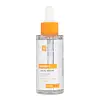Estée Lauder Resilience Multi-Effect Tri-Peptide Face And Neck Creme SPF 15 Versus Global Beauty Care Vitamin C Facial Serum
What's inside
What's inside
 Key Ingredients
Key Ingredients

 Benefits
Benefits

 Concerns
Concerns

 Ingredients Side-by-side
Ingredients Side-by-side

Water
Skin ConditioningNeopentyl Glycol Diheptanoate
EmollientEthylhexyl Salicylate
UV AbsorberButyl Methoxydibenzoylmethane
UV AbsorberOctocrylene
UV AbsorberCetyl Alcohol
EmollientGlycerin
HumectantButyloctyl Salicylate
Skin ConditioningPentaerythrityl Tetraethylhexanoate
EmollientPolyethylene
AbrasiveDi-C12-15 Alkyl Fumarate
EmollientPetrolatum
EmollientHydrogenated Lecithin
EmulsifyingButylene Glycol
HumectantPropanediol
SolventHydrogenated Polyisobutene
EmollientOctyldodecyl Myristate
EmollientHexyldecyl Stearate
EmollientBehenyl Alcohol
EmollientCucumis Melo Fruit Extract
Skin ConditioningPolygonum Aviculare Extract
EmollientMyrtus Communis Leaf Extract
PerfumingLaminaria Digitata Extract
Skin ProtectingAcetyl Hexapeptide-8
HumectantTetradecyl Aminobutyroylvalylaminobutyric Urea Trifluoroacetate
Skin ConditioningLactoperoxidase
StabilisingGlucose Oxidase
StabilisingCholesterol
EmollientPropylene Glycol Dicaprylate
EmollientAminopropyl Ascorbyl Phosphate
AntioxidantSodium Hyaluronate
HumectantGlucose
HumectantAlgae Extract
EmollientArtemia Extract
Skin ConditioningAcetyl Glucosamine
Skin ConditioningSigesbeckia Orientalis Extract
Skin ConditioningGlyceryl Stearate
EmollientPersea Gratissima Oil
Skin ConditioningDimethicone
EmollientC12-16 Alcohols
EmollientTrehalose
HumectantEthylhexylglycerin
Skin ConditioningPEG-100 Stearate
Caffeine
Skin ConditioningPalmitic Acid
EmollientGlycine Soja Sterols
EmollientCaprylyl Glycol
EmollientIsohexadecane
EmollientPolymethyl Methacrylate
Trifluoroacetyl Tripeptide-2
Skin ConditioningTocopheryl Acetate
AntioxidantZinc PCA
HumectantPolysilicone-11
Polysorbate 80
EmulsifyingYeast Extract
Skin ConditioningPotato Starch Modified
Decarboxy Carnosine Hcl
Skin ConditioningXanthan Gum
EmulsifyingParfum
MaskingSodium Hydroxide
BufferingPotassium Sulfate
Acrylamide/Sodium Acryloyldimethyltaurate Copolymer
Emulsion StabilisingDextran
Hexylene Glycol
EmulsifyingDisodium EDTA
BHT
AntioxidantPotassium Sorbate
PreservativePhenoxyethanol
PreservativeCI 14700
Cosmetic ColorantMica
Cosmetic ColorantCI 77891
Cosmetic ColorantWater, Neopentyl Glycol Diheptanoate, Ethylhexyl Salicylate, Butyl Methoxydibenzoylmethane, Octocrylene, Cetyl Alcohol, Glycerin, Butyloctyl Salicylate, Pentaerythrityl Tetraethylhexanoate, Polyethylene, Di-C12-15 Alkyl Fumarate, Petrolatum, Hydrogenated Lecithin, Butylene Glycol, Propanediol, Hydrogenated Polyisobutene, Octyldodecyl Myristate, Hexyldecyl Stearate, Behenyl Alcohol, Cucumis Melo Fruit Extract, Polygonum Aviculare Extract, Myrtus Communis Leaf Extract, Laminaria Digitata Extract, Acetyl Hexapeptide-8, Tetradecyl Aminobutyroylvalylaminobutyric Urea Trifluoroacetate, Lactoperoxidase, Glucose Oxidase, Cholesterol, Propylene Glycol Dicaprylate, Aminopropyl Ascorbyl Phosphate, Sodium Hyaluronate, Glucose, Algae Extract, Artemia Extract, Acetyl Glucosamine, Sigesbeckia Orientalis Extract, Glyceryl Stearate, Persea Gratissima Oil, Dimethicone, C12-16 Alcohols, Trehalose, Ethylhexylglycerin, PEG-100 Stearate, Caffeine, Palmitic Acid, Glycine Soja Sterols, Caprylyl Glycol, Isohexadecane, Polymethyl Methacrylate, Trifluoroacetyl Tripeptide-2, Tocopheryl Acetate, Zinc PCA, Polysilicone-11, Polysorbate 80, Yeast Extract, Potato Starch Modified, Decarboxy Carnosine Hcl, Xanthan Gum, Parfum, Sodium Hydroxide, Potassium Sulfate, Acrylamide/Sodium Acryloyldimethyltaurate Copolymer, Dextran, Hexylene Glycol, Disodium EDTA, BHT, Potassium Sorbate, Phenoxyethanol, CI 14700, Mica, CI 77891
Water
Skin ConditioningGlycerin
HumectantHydrogenated Starch Hydrolysate
HumectantPropylene Glycol
HumectantMethyl Gluceth-20
HumectantPortulaca Oleracea Extract
Skin ConditioningAllantoin
Skin ConditioningAcrylates/C10-30 Alkyl Acrylate Crosspolymer
Emulsion StabilisingArginine
Masking1,2-Hexanediol
Skin ConditioningGlycolic Acid
BufferingPhenoxyethanol
PreservativeHyaluronic Acid
HumectantHydroxyethylcellulose
Emulsion StabilisingCaprylhydroxamic Acid
Ascorbic Acid
AntioxidantPEG-20
HumectantDisodium EDTA
Ethylhexylglycerin
Skin ConditioningPhospholipids
Skin ConditioningCaprylic/Capric Glycerides
EmollientWater, Glycerin, Hydrogenated Starch Hydrolysate, Propylene Glycol, Methyl Gluceth-20, Portulaca Oleracea Extract, Allantoin, Acrylates/C10-30 Alkyl Acrylate Crosspolymer, Arginine, 1,2-Hexanediol, Glycolic Acid, Phenoxyethanol, Hyaluronic Acid, Hydroxyethylcellulose, Caprylhydroxamic Acid, Ascorbic Acid, PEG-20, Disodium EDTA, Ethylhexylglycerin, Phospholipids, Caprylic/Capric Glycerides
Ingredients Explained
These ingredients are found in both products.
Ingredients higher up in an ingredient list are typically present in a larger amount.
Disodium EDTA plays a role in making products more stable by aiding other preservatives.
It is a chelating agent, meaning it neutralizes metal ions that may be found in a product.
Disodium EDTA is a salt of edetic acid and is found to be safe in cosmetic ingredients.
Learn more about Disodium EDTAEthylhexylglycerin (we can't pronounce this either) is commonly used as a preservative and skin softener. It is derived from glyceryl.
You might see Ethylhexylglycerin often paired with other preservatives such as phenoxyethanol. Ethylhexylglycerin has been found to increase the effectiveness of these other preservatives.
Glycerin is already naturally found in your skin. It helps moisturize and protect your skin.
A study from 2016 found glycerin to be more effective as a humectant than AHAs and hyaluronic acid.
As a humectant, it helps the skin stay hydrated by pulling moisture to your skin. The low molecular weight of glycerin allows it to pull moisture into the deeper layers of your skin.
Hydrated skin improves your skin barrier; Your skin barrier helps protect against irritants and bacteria.
Glycerin has also been found to have antimicrobial and antiviral properties. Due to these properties, glycerin is often used in wound and burn treatments.
In cosmetics, glycerin is usually derived from plants such as soybean or palm. However, it can also be sourced from animals, such as tallow or animal fat.
This ingredient is organic, colorless, odorless, and non-toxic.
Glycerin is the name for this ingredient in American English. British English uses Glycerol/Glycerine.
Learn more about GlycerinPhenoxyethanol is a preservative that has germicide, antimicrobial, and aromatic properties. Studies show that phenoxyethanol can prevent microbial growth. By itself, it has a scent that is similar to that of a rose.
It's often used in formulations along with Caprylyl Glycol to preserve the shelf life of products.
Water. It's the most common cosmetic ingredient of all. You'll usually see it at the top of ingredient lists, meaning that it makes up the largest part of the product.
So why is it so popular? Water most often acts as a solvent - this means that it helps dissolve other ingredients into the formulation.
You'll also recognize water as that liquid we all need to stay alive. If you see this, drink a glass of water. Stay hydrated!
Learn more about Water